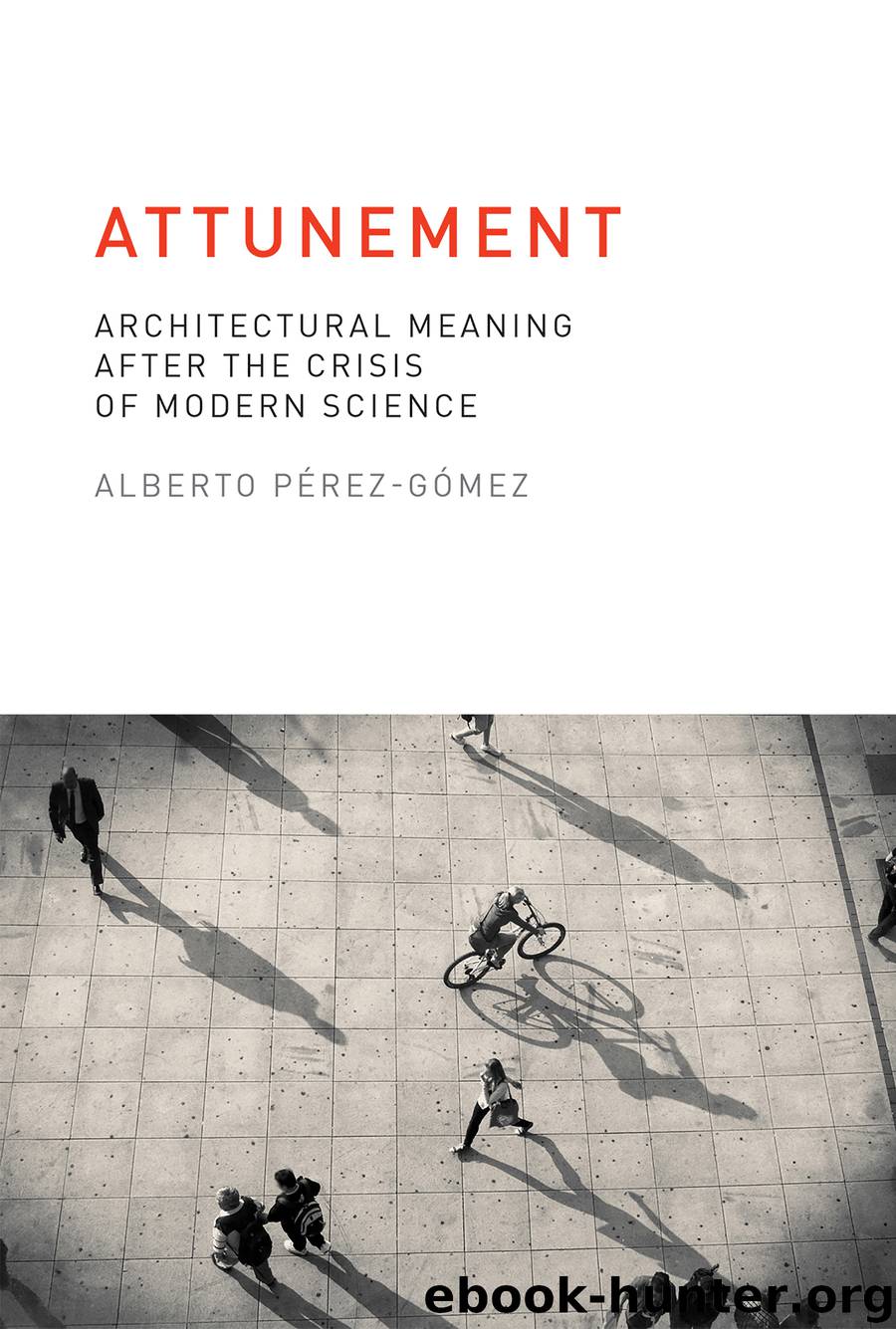Attunement by Pérez-Gómez Alberto;

Author:Pérez-Gómez, Alberto;
Language: eng
Format: epub
Publisher: MIT Press
Published: 2016-04-15T04:00:00+00:00
6
The Linguistic Dimension of Architecture: Attunement and the Poetic Word
In the preceding pages, I hope to have established the primary connections at work between natural language and Stimmung in embodied consciousness. At this point, I would like to explore further the phenomenology of language, unpacking its potential for architectural design. Our entry point will be a clarification of the divergences and connections between the “language of architecture” proper and the language through which the architect may represent his or her intentions in the design of attuned environments. Both aspects are complex, and much confusion arises from both a misunderstanding of the nature of language itself (obviously still a highly debated issue among linguists, philosophers, philologists, media theorists, and cognitive scientists) and the expectations commonly associated with the products of our technological civilization. The result has been a reluctance to consider the possibilities of poetic language in the design process, while privileging functional, typological, stylistic, or parametric strategies. Natural language is marginalized to operate at best as the language of rational consensus in architect-client negotiations, or serving as the “specifications” in traditional hands-on construction or the language of industry standards in more recent technological fabrication.
Furthermore, even in cases where modern and contemporary architects have pursued interests in narrative and associated architecture with language, fundamental assumptions have usually been drawn from Saussurian semiotics and Derridian poststructuralism. Strikingly, these assumptions also underscore the otherwise positive recent trend in cultural studies to consider art and architecture as “media” communicating in multiple registers, yet often limited and misleading in their characterization of architectural “messages” as mostly ideological. Such top-down constructivist theories of language will be shown to be at odds with the concept of emerging language in phenomenology and hermeneutics. Regarding languages as ultimately arbitrary codes more or less independent of lived experience and built upon a misconception concerning the nature of lived temporality (as explained in the last chapter), constructivist theories prioritize writing over orality as the primary modality of meaning. Transferred to the realm of architecture, such theories fail to do justice to the human experience of communicative settings for action in the lived present.
I. The Voices (Stimme) of Architecture
In The Bow and the Lyre, his remarkable study on the nature of poetry, Octavio Paz explains why it is no accident that critics speak of “plastic” or “musical languages” and extend the notion of the poetic beyond the crafting of poems. As soon as brute sounds or colors are perceived by human consciousness (remember—perception is action) and touched by human hands, their nature changes and they enter a linguistic horizon, becoming the materials for works. As Paz summarizes: “And all works end as meaning; whatever man touches is tinged with intentionality.”1 The human world is a world of meaning, one that “tolerates ambiguity, contradiction, madness, or confusion, but not lack of meaning.”2 Frank Wilson writes succinctly: “Language is not just words, semantics, syntax. It is also melody, and sometimes it is a dance. Sometimes, as in the deaf, it is a silent dance of the hands.
Download
This site does not store any files on its server. We only index and link to content provided by other sites. Please contact the content providers to delete copyright contents if any and email us, we'll remove relevant links or contents immediately.
Kathy Andrews Collection by Kathy Andrews(11326)
The remains of the day by Kazuo Ishiguro(8396)
Paper Towns by Green John(4800)
Spare by Prince Harry The Duke of Sussex(4789)
Industrial Automation from Scratch: A hands-on guide to using sensors, actuators, PLCs, HMIs, and SCADA to automate industrial processes by Olushola Akande(4609)
The Body: A Guide for Occupants by Bill Bryson(4586)
Be in a Treehouse by Pete Nelson(3648)
Machine Learning at Scale with H2O by Gregory Keys | David Whiting(3634)
Harry Potter and the Goblet Of Fire by J.K. Rowling(3611)
Never by Ken Follett(3529)
Goodbye Paradise(3448)
The Remains of the Day by Kazuo Ishiguro(3139)
Into Thin Air by Jon Krakauer(3131)
The Cellar by Natasha Preston(3077)
The Genius of Japanese Carpentry by Azby Brown(3040)
Fairy Tale by Stephen King(2950)
120 Days of Sodom by Marquis de Sade(2941)
Drawing Shortcuts: Developing Quick Drawing Skills Using Today's Technology by Leggitt Jim(2941)
The Man Who Died Twice by Richard Osman(2809)
